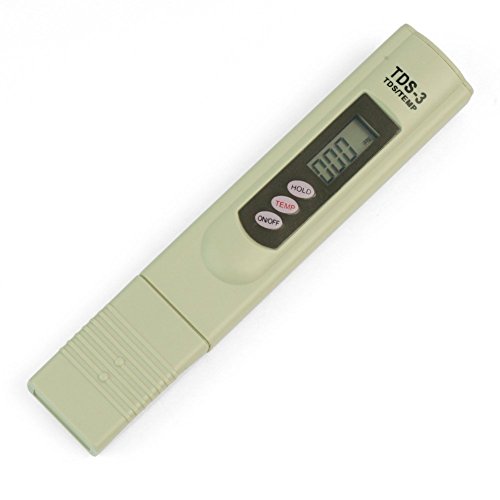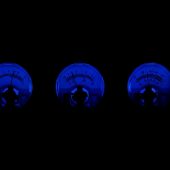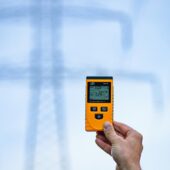A TDS meter measures the amount of total dissolved solids in water. It does this by measuring the waters electrical conductivity then converting that to TDS readings. TDS meters have built-in automatic temperature compensation (ATC) to ensure correct TDS measurements.
Total dissolved solid (TDS) comprise all organic and inorganic solids that are dissolved in water including salts, metals and chemicals.
Hard water minerals like calcium and magnesium, surface runoff minerals like phosphates, de-icing salts and harmful impurities like arsenic and lead all make up the TDS content of water.
You can use a TDS meter at home to check the quality of your tap water or see if your filtration system is working properly (by testing the water coming out of the filter).
A TDS meter is also used in aquariums, gardens, hydroponic farming and many other applications where the nature and quality of water is important. Note that a TDS meter does not measure water hardness. For that, you’ll need a hardness test kit.
In this buying guide, we review the best TDS meters on the UK market and give you some tips for choosing the right one for your testing needs.
Key Considerations When Choosing a TDS Meter
A. Measurements
Virtually all the TDS meters you’ll come across can take at least three measurements.
- Electrical conductivity (EC) – TDS meters are actually EC meters. They measure the electrical conductivity in water then use it to determine TDS. EC will be displayed in microsiemens (uS), milisiemens (mS) or siemens (S).
- TDS – TDS levels will be shown in PPM or parts per million.
- Temperature – Because all TDS meters have a built-in temperature sensor (important for automatic temperature compensation), they display water temperature alongside TDS and EC.
Some TDS meters also offer pH readings, handy for aquariums, swimming pools and hydroponics.
B. Display
Because TDS meters are small, the display is also small. But the numbers should be large to make it easy to see measurements.
We also recommend getting a TDS meter with a backlit display. It’ll make it much easier to see readings on the small screen.
- Read also: How To Choose The Best EMF Meters?
C. Accuracy and Resolution
Generally, a more expensive TDS meters will deliver more accuracy. If your application requires high precision, spend more on good quality TDS meter with a narrow margin of error and fine resolution (0.1 ppm resolution is ideal, especially for lower readings).
For most applications however, a cheaper less precise TDS meter will do. For things like drinking water or an aquarium, a resolution of 1PPM and an accuracy of ± 2% – 5% are acceptable.
Remember that the accuracy of a TDS meter also depends a lot on how you take a reading. Make sure you follow the testing instructions from the manufacturer. If they recommend testing with flowing water, do that.
If you are testing standing water in a container, stir the water with the meter to dissipate any air bubble and ensure uniformity.
D. Calibration Mode
Another way to improve measurement accuracy is to get a TDS meter that can be calibrated. Most TDS meters come pre-calibrated in the factory, but they can get off-kilter after some time.
Re-calibrating the meter keeps it accurate.
Note that you’ll need to buy a calibration solution to accurately re-calibrate your TDS meter. The HM Digital NaCl calibration solution is the best one for all TDS meter brands.
E. Waterproof
With a waterproof TDS meter, you don’t have to worry about accidentally dropping it in water or putting it in too deep. On the downside, you’ll have to pay more for such a TDS meter.
As long as you are careful, a cheaper TDS meter without any water protection will be good enough. But if you expect to take frequent TDS reading, it might be worth it to spend more on a waterproof and dustproof meter that will last longer.
F. Other Features
- Hold function – Freezes readings on the display, allowing you to see the measurement even after you remove the meter from the water.
- Auto-off – Turns the display off after a few minutes of unused to conserve battery life.
Best TDS Meters: Top 5 Reviews
1. HM Digital COM-100 Waterproof EC/TDS/Temp Meter Review

The HM Digital COM-100 costs more than most TDS meters. It’s also more accurate and better made than other cheaper meters.
We recommend the HM Digital COM-100 for pros and anyone who wants an accurate TDS meter that will last a long time.
The COM-100 is waterproof and dustproof, which is one of the reasons it’s more reliable and durable than other TDS meters.
You can take three different kinds of measurements with the COM-100: TDS, EC and water temperature. TDS range is 0 – 8560 ppm with a resolution of 0.1 ppm for low readings up to 99 ppm, 1 ppm for readings between 100 and 999 and 10 ppm for readings over 1000.
Temperature range is 0-55 °C and EC range is 0 – 9990 µS.
Numbers on the display are big and we love that it shows two readings simultaneously. There’s a convenient hold function so you don’t have to struggle to see the reading while the meter is still immersed in water.
Unfortunately, the display is not backlit, which is surprising considering the price. You’ll have a hard time seeing readings if it’s dark.
One of the best features of the COM-100 TDS meter is the replaceable sensor. If the sensor stops working or gets damaged, you don’t have to replace the entire meter; just get the HM Digital SP-C1 Replacement Sensor.
Other notable features include digital calibration, auto-off, multiple units of measurement and low battery indicator.
What we like about it:
- Waterproof and dustproof.
- Replaceable sensor.
- High accuracy.
- Can be re-calibrated.
2. HM Digital DM-1 in-Line Dual TDS Monitor Review

If you need to constantly monitor TDS levels in water, an in-line meter is a better option. We recommend the HM Digital DM-1 in-line TDS monitor.
What we like most about the DM-1 is that it is a dual system. This is great for water filtration systems such as reverse osmosis filters. You can monitor the TDS levels of tap water going into the filter as well as the TDS levels of filtered water.
By comparing the two, you can see by how much your filter lowers TDS levels, giving you a better idea of its filtration performance.
You’ll need to install this monitor in-line using the quick connect ¼” T fittings. If your RO system uses a different size of fittings, you can order 3/8” or 1/2″ fittings separately.
Each fitting is clearly marked IN (for tap water) or OUT (for filtered/purified water) so you’ll know where to install it. Once installed, you can switch between IN and OUT readings on the small display.
The DM-1 only shows TDS readings. Unlike handheld TDS meters, it does not show EC or temperature.
The TDS measurement range is 0-9990 ppm with a resolution of 1 ppm between 0 and 999 and 10 ppm between 1,000 and 9,990. Accuracy is ±2%.
The DM-1 in-line TDS monitor runs on two button cell batteries with a lifespan of about a thousand hours.
What we like about it:
- Dual probes makes it perfect for monitoring filtration systems.
- Wide measurement range.
- Easy to install.
3. CAMWAY Digital TDS Tester Pen Review

If you need a TDS meter you can carry around with you, we recommend the CAMWAY digital TDS tester. The pen-style meter comes with its own little case, so you can carry it in your pocket or toolbox.
The tester measures the usual three parameters: TDS, EC and temperature. TDS range is 0-9999 ppm with an accuracy of ± 2%.
The display is backlit, making it easy to see measurements even in the dark. The backlight also acts as a warning system when you are measuring drinking water. If TDS is lower than 40 ppm, it’ll light up in green. If it’s over 40 ppm, it’ll light up in red to indicate the water may not be safe for drinking.
Note, however, that a reading of higher than 40 ppm is not always an indication of unsafe water. Clean drinking water with hardness salts and healthy minerals may have a reading higher than that.
The 40 ppm cutoff mark is more helpful when testing water from an RO system. A functional RO filter should produce water with very low TDS levels.
The CAMWAY digital TDS tester includes a HOLD function for easier measurement reading and auto-off to conserve battery life.
What we like about it:
- Low price.
- Easy to carry around.
- Multiple measurements.
- Backlit display.
4. Health Metric TDS Meter Review
The Health Metric TDS meter is another good option if portability is important to you. It’s small and comes with a case.
The backlit display shows TDS, temperature and EC readings. TDS range is 0-9999 ppm, EC range is 0-9990 μs/cm and temperature range is 1-80°C.
You can hold readings on the screen so you don’t have to bend to check the measurements. The meter also comes with a battery-saving auto-off function.
The Health Metric TDS meter comes already calibrated, but you can re-calibrate it using an NaCl calibration solution.
What we like about it:
- Low price.
- Easy portability.
- Backlit screen.
- Can be re-calibrated.
5. Yakamoz LCD Digital TDS-3 Meter Review

The Yakamoz TDS meter is a great choice if you are on a budget. It is the cheapest option among our picks.
The display indicates only TDS levels; no EC or temperature readings. As expected for the price, the display is not backlit.
But it is highly accurate, and that’s what matters most. The accuracy is +/- 2% and the TDS range is 0 to 9,990 ppm.
The Yakamoz TDS meter includes a hold function, but some users say it’s inconvenient to use it since you have to hold it down continuously for the display to hold the reading.
What we like about it:
- Inexpensive.
- Includes hold function.
- High accuracy.



Hi Jack… fabulous read,thank you 😊.
My concern is that my zero water filter came with a TDS meter which is great,I change the filter now by taste change and just confirm with my meter,change filter and it’s back to zero !However I’ve recently started collecting water from Birchover in Derbyshire from a well, tastes amazing but my meter reading is just over 300! My berkefeld water filter reads around 125! Please help me to understand this! I want to drink good water and can’t afford a home system (osmosis) and a destiller keeps popping into my mind..🙏🏼